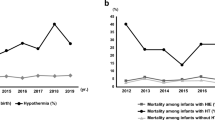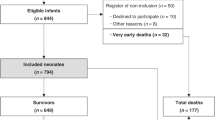Abstract
Introduction
There is an extensive body of research regarding neurological outcomes following neonatal hypoxic-ischemic encephalopathy (HIE) treated with therapeutic hypothermia (TH), with limited data on growth outcomes. We examined perinatal characteristics associated with postnatal growth in this population.
Methods
Convenience cohort of 66 infants with HIE who underwent TH and participated in follow-up at 24 months of age were included. Regression modeling including perinatal anthropomorphics, markers of HIE, and systemic injury was used to evaluate growth at 24 months.
Results
Birth head circumference was associated with weight (p = 0.036). MRI severity, pH at admission and birth head circumference were associated with height (p = 0.043, p = 0.015 and p = 0.043 respectively). MRI severity and length of intubation were associated with head circumference (p = 0.038 and p < 0.001 respectively).
Conclusion
There was a significant association between specific early factors and growth at 24 months among infants with HIE treated with TH.



Similar content being viewed by others
Data availability
The dataset of which this paper is based is a small pilot sample and is not retained or publicly archived.
References
Kurinczuk JJ, White-Koning M, Badawi N. Epidemiology of neonatal encephalopathy and hypoxic-ischaemic encephalopathy. Early Hum Dev. 2010;86:329–38. https://doi.org/10.1016/j.earlhumdev.2010.05.010
de Vries LS, Jongmans MJ. Long-term outcome after neonatal hypoxic-ischaemic encephalopathy. Arch Dis Child Fetal Neonatal Ed. 2010;95:F220–4.
Kattwinkel J, Perlman JM, Aziz K, Colby C, Fairchild K, Gallagher J, et al. Part 15: Neonatal Resuscitation: 2010 American Heart Association Guidelines for Cardiopulmonary Resuscitation and Emergency Cardiovascular Care. Circulation. 2010;122. Available from: https://www.ahajournals.org/doi/10.1161/CIRCULATIONAHA.110.971119
Vohr BR, Stephens BE, McDonald SA, Ehrenkranz RA, Laptook AR, Pappas A, et al. Cerebral palsy and growth failure at 6 to 7 years. Pediatrics. 2013;132:e905–14.
Preeti S, Kadam A, Kadam S, Vaidya U, Kumar P, Bhagat I, et al. Anthropometric measures as biomarkers of neurodevelopmental outcomes of newborns with moderate to severe hypoxic ischemic encephalopathy. J Neonatal Perinat Med. 2019;12:127–34.
Shah P. Multiorgan dysfunction in infants with post-asphyxial hypoxic-ischaemic encephalopathy. Arch Dis Child Fetal Neonatal Ed. 2004;89:152F–155.
Hankins G. Neonatal organ system injury in acute birth asphyxia sufficient to result in neonatal encephalopathy. Obstet Gynecol. 2002;99:688–91.
Sarkar S, Askenazi DJ, Jordan BK, Bhagat I, Bapuraj JR, Dechert RE, et al. Relationship between acute kidney injury and brain MRI findings in asphyxiated newborns after therapeutic hypothermia. Pediatr Res. 2014;75:431–5.
Shellhaas RA, Kushwaha JS, Plegue MA, Selewski DT, Barks JDE. An evaluation of cerebral and systemic predictors of 18-month outcomes for neonates with hypoxic ischemic encephalopathy. J Child Neurol. 2015;30:1526–31.
Sarnat HB. Neonatal encephalopathy following fetal distress: a clinical and electroencephalographic study. Arch Neurol. 1976;33:696
Shankaran S, Laptook AR, Ehrenkranz RA, Tyson JE, McDonald SA, Donovan EF, et al. Whole-body hypothermia for neonates with hypoxic–ischemic encephalopathy. N Engl J Med. 2005;353:1574–84.
Shankaran S, Barnes PD, Hintz SR, Laptook AR, Zaterka-Baxter KM, McDonald SA, et al. Brain injury following trial of hypothermia for neonatal hypoxic-ischaemic encephalopathy. Arch Dis Child Fetal Neonatal Ed. 2012;97:F398–404.
Chin EM, Jayakumar S, Ramos E, Gerner G, Soares BP, Cristofalo E, et al. Preschool language outcomes following perinatal hypoxic-ischemic encephalopathy in the age of therapeutic hypothermia. Dev Neurosci. 2018;40:627–37.
Thomas AJ, Eberly LE, Davey Smith G, Neaton JD. ZIP-code-based versus tract-based income measures as long-term risk-adjusted mortality predictors. Am J Epidemiol. 2006;164:586–90.
Roux AVD, Kiefe CI, Jacobs DR, Haan M, Jackson SA, Nieto FJ, et al. Area characteristics and individual-level socioeconomic position indicators in three population-based epidemiologic studies. Ann Epidemiol. 2001;11:395–405.
Mercuri E, Ricci D, Cowan FM, Lessing D, Frisone MF, Haataja L, et al. Head growth in infants with hypoxic–ischemic encephalopathy: correlation with neonatal magnetic resonance imaging. Pediatrics. 2000;106:235–43.
Martinez-Biarge M, Bregant T, Wusthoff CJ, Chew ATM, Diez-Sebastian J, Rutherford MA, et al. White Matter and cortical injury in hypoxic-ischemic encephalopathy: antecedent factors and 2-year outcome. J Pediatr. 2012;161:799–807.
Gancia P, Pomero G. Therapeutic hypothermia in the prevention of hypoxic-ischaemic encephalopathy: new categories to be enrolled. J Matern Fetal Neonatal Med. 2012;25:94–6.
Peeters LLH, Sheldon RE, Jones MD, Makowski EL, Meschia G. Blood flow to fetal organs as a function of arterial oxygen content. Am J Obstet Gynecol. 1979;135:637–46.
Natarajan G, Pappas A, Shankaran S. Outcomes in childhood following therapeutic hypothermia for neonatal hypoxic-ischemic encephalopathy (HIE). Semin Perinatol. 2016;40:549–55.
Acknowledgements
We acknowledge the members of the Johns Hopkins Neurosciences Intensive Care Nursery whose collaboration has provided a platform for this research. We are particularly grateful to the participants and their families without whom this research would not be possible.
Funding
Vera Joanna Burton was supported by the NINDS/NIH K12-NS001696 during data collection for this project. Vera Joanna Burton, Gwendolyn Gerner, Frances Northington and Raul Chavez-Valdez were all supported in part by NIH/NICHD 1 R01 HD086058-01A1 during the preparation of this manuscript.
Author information
Authors and Affiliations
Contributions
Srishti Jayakumar participated in the data collection for the project, as well as analysis and writing of this manuscript. Vera Joanna Burton participated in the conceptualization and data collection for the project, as well as analysis and writing of this manuscript. Jamie Perin participated in the analysis and reviewed this manuscript. Daniella Asafu-Adjaye participated in data collection for the project and reviewed this manuscript. Elizabeth Cristofalo participated in the conceptualization and data collection for this project and reviewed the manuscript. Frances Northington participated in the conceptualization of this project and reviewed the manuscript. Raul Chavez-Valdez Northington participated in the conceptualization of this project and reviewed the manuscript. Mary Leppert participated in the conceptualization of this project and reviewed the manuscript. Marilee Allen participated in the conceptualization of this project and reviewed the manuscript. Gwendolyn Gerner participated in the conceptualization and data collection for the project, as well as analysis and writing of this manuscript.
Corresponding author
Ethics declarations
Competing interests
The authors declare no competing interests.
Statement of ethics
Study approval statement: The study was approved by the Institutional Review Board at Johns Hopkins University School of Medicine (IRB00133750). Written consent was obtained for the use of study participant data. This is not a clinical trial nor did it contain any experiments with animals.
Additional information
Publisher’s note Springer Nature remains neutral with regard to jurisdictional claims in published maps and institutional affiliations.
Rights and permissions
Springer Nature or its licensor (e.g. a society or other partner) holds exclusive rights to this article under a publishing agreement with the author(s) or other rightsholder(s); author self-archiving of the accepted manuscript version of this article is solely governed by the terms of such publishing agreement and applicable law.
About this article
Cite this article
Jayakumar, S., Burton, V.J., Perin, J. et al. Factors affecting early childhood growth in hypoxic-ischemic encephalopathy treated with hypothermia. J Perinatol 44, 532–538 (2024). https://doi.org/10.1038/s41372-024-01890-x
Received:
Revised:
Accepted:
Published:
Issue Date:
DOI: https://doi.org/10.1038/s41372-024-01890-x
- Springer Nature America, Inc.




